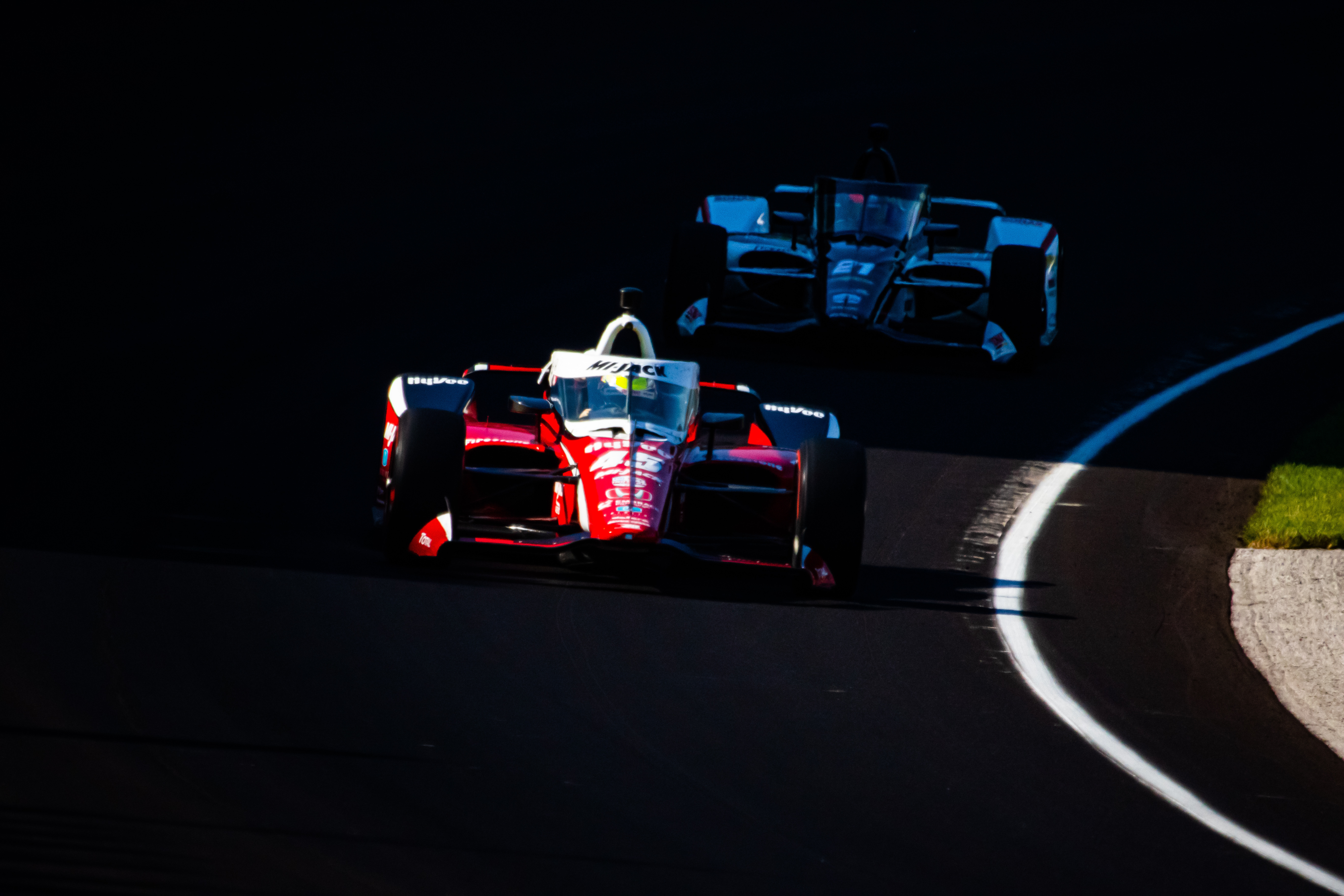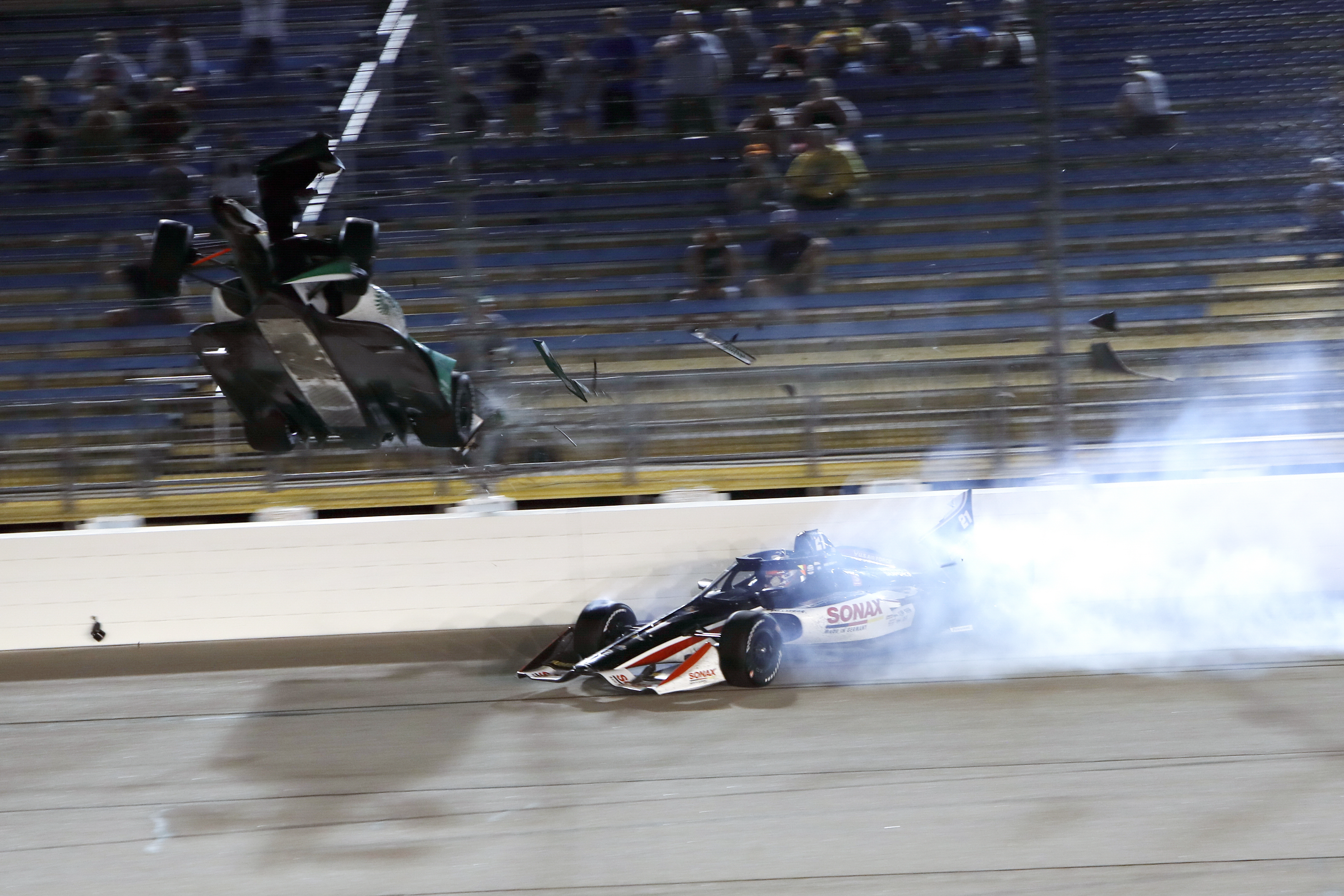until Abu Dhabi Autonomous Racing League

There’s been more than enough evidence in the 2020 IndyCar season that the aeroscreen is a life-saving development worth every bit of additional work it’s created for the teams.
Last weekend on IndyCar’s biggest stage of all, the Red Bull Technology designed aeroscreen had its most public demonstration so far when a particularly vicious crash brought the race to a premature end.
While Oliver Askew, Ed Carpenter, James Davison, Conor Daly, Marcus Ericsson, Dalton Kellett, Alex Palou and Alexander Rossi all had incidents in the Indianapolis 500, it was Spencer Pigot’s that perhaps raised the biggest question mark as he crashed into the end of pitwall, or at least the tyres protecting it.
What a brutal crash for Spencer Pigot with 4 laps to go in the #Indy500 pic.twitter.com/7cJQ5bR5Uv
— Matt Mayer (@MatthewMayerCBS) August 23, 2020
A few days on from that shunt, a reflective Pigot talked to The Race about how the crash unfolded and the aeroscreen’s role in protecting him.
But our first question was about some social media suggestions that a suspension component had pierced the screen – something IndyCar has since made clear wasn’t the case.
“They just had to sit me down for a few seconds and then everything was OK after that” :: Spencer Pigot
Immediately after the race, speculation that the Citrone Buhl Autosport car’s aeroscreen had been breached began. However, Pigot didn’t believe that had happened.
“No, I’m pretty sure that nothing went through the screen,” Pigot told The Race.
“I think there were were some scratches or stuff on the screen that [showed] the protection it provided from anything coming into the cockpit but as far as I’m aware the screen was fully intact and didn’t have any issues.”

An IndyCar insider told The Race that the series investigates all its accidents and usually takes weeks to go through the data in a studious manner. However, it was confirmed to us that the screen was not “pierced or penetrated” during the accident.
Pigot hit the wall fairly early in the corner, but it was a broken suspension part that broke “in an unfortunate way” that shot the car back across the track and towards the pitwall.
There were some concerns for Pigot’s safety after cameras initially showed the 26-year-old get out of the cockpit but then a close-up showed a shocked and colourless figure sat on the asphalt following the incident.
“I definitely remember everything,” added Pigot.
“Typically, that’s the most dangerous part of the car so to have the added protection this year has been fantastic” :: Spencer Pigot
“The guys helped me get out of the car but I was fully aware of everything that was going on and then after I got out and stood up just… I don’t know if it was a combination of just the adrenaline wearing off and obviously the end of the race, sweating a lot being probably a little dehydrated.
“They just had to sit me down for a few seconds and then everything was OK after that.”
Pigot was taken to Methodist Hospital but released soon after and was back at the track the next day following what looked like a miraculous escape.
It’s very difficult to quantify in crashes if the aeroscreen has saved a life or not, but the evidence is stacking up for it doing so.
There were marks on Rinus VeeKay’s aeroscreen after Colton Herta’s car was launched over VeeKay’s at Iowa, and debris from that crash hit Marcus Ericsson’s aeroscreen.
The device has proven troublesome for teams, in terms of having to go back to the drawing board with set-ups as the added weight high up and to the front of the car alters the handling and aerodynamics significantly.
It’s also made the cockpit much hotter, which was a serious issue for drivers earlier in the season but IndyCar has and is working on fixes to increase air flow to drivers and increase comfort.
However, those are all small fry when you consider a person’s life at stake.
“When you get in the car, it’s not something that you’re thinking about [safety],” adds Pigot.
“I still would be racing I guess if we didn’t have the aeroscreen obviously, it wasn’t a make or break in terms of me wanting to drive IndyCars but it makes you feel so much better for sure when you hop in a car knowing all the work that’s been done and how that’s such a big advancement in safety.
“Typically, that’s the most dangerous part of the car so to have the added protection this year has been fantastic.

“It looks like we’ve kind of tested the aeroscreen a couple of times and it’s definitely held up to the expectations.
“I think everyone, all the drivers and everyone involved in IndyCar racing, is very thankful for the people that developed it.
“It does have its struggles, maybe it’s a bit harder for the teams to work on the car, maybe changes the handling a little bit, it’s definitely a little bit hotter inside the cockpit, but I think the pros definitely outweigh all the cons.”
IndyCar was criticised for not throwing the red flag following Pigot’s crash in order to make barrier repairs and restart the Indy 500 with just a few laps remaining.
It issued a statement saying: “IndyCar makes every effort to end races under green, but in this case following the assessment of the incident, there were too few laps remaining to gather the field behind the pace car, issue a red flag and then restart for a green-flag finish.”
Since then, one of the drivers who was robbed of the shot at victory, Graham Rahal, came out in support of the decision.
Nope. While I wanted a chance at the W, a 1.5 hour track repair combined with the fact there are no gimmicks in @IndyCar racing means the #Indy500 ran its course like it should’ve. Some may be upset, but as a competitor that’s the way it’s always been and should be. https://t.co/Grpypxz717
— Graham Rahal (@GrahamRahal) August 25, 2020
Another incident that went slightly under the radar in terms of the aeroscreen was James Davison’s dramatic early exit. Just four laps into the race his front-right wheel effectively exploded!
His fiery machine toured briefly until he pulled over and safety crews extinguished the fire that – burning magnesium – must have been an incredible temperature.
Worth mentioning. We still don’t definitively know what caused the brake malfunction.
The data shows the front brake pressure slowly started on the pace laps. The moment I took the green it exponentially ramped to 250+ psi. Bizarre. pic.twitter.com/NMdxwyAJ5n
— James Davison (@JD33Davison) August 27, 2020
In a series of tweets afterwards, Davison confirmed IndyCar called him to discuss the fire and how the aeroscreen performed in protecting him from it, also contemplating the reason why it happened in the first place.
The Indy 500 is by far the most watched race of IndyCar’s season, and for many it was the first time to see the aeroscreen in action with added interest in the race abroad.
There’s no doubt for those that haven’t seen it earlier in the season, the device lived up to the occasion and proved once more that it is a lifesaver.


